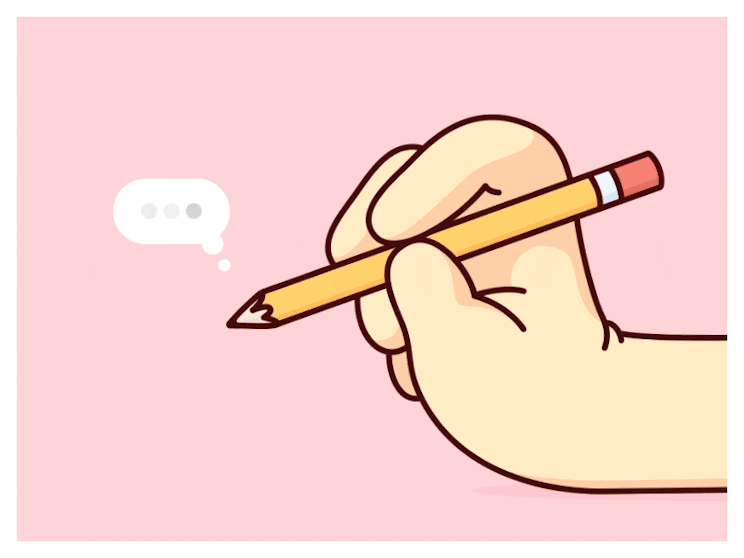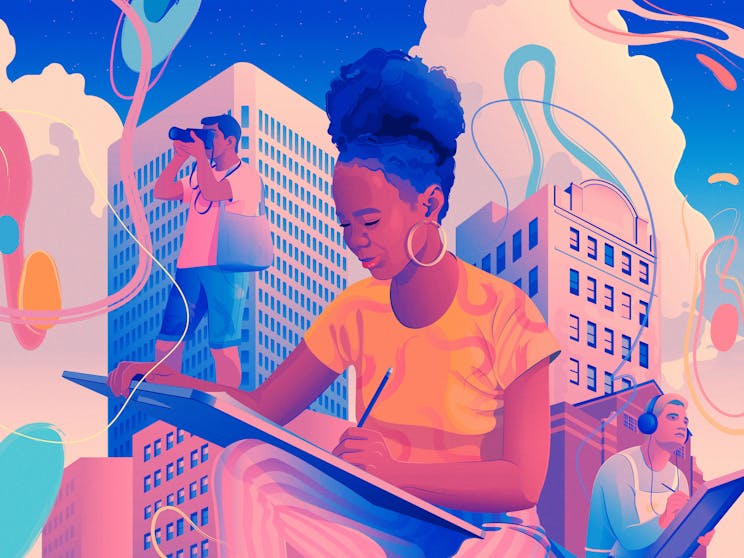how to draw 3d illustration
Education
A Beginner'due south Guide to Learning 3D Design & Illustration
Everything y'all need to go started in 3D design and illustration. Learn the right 3D tools to use, where to learn, and the all-time industries for you lot to explore.
![]()
January 05, 2022
Learn Design
3D design isn't as scary as yous think! In this beginner's guide, designer and teacherRoman Klčo explains how to start learning 3D, the correct tools to use, and the best industries for you to explore based on your background.
What started decades ago as a cutting-edge technology that transformed many industries is now a user-friendly design tool that's more available than ever.
Today, when yous open Dribbble's homepage, you'll come across tons of beautiful 3D designs. 3D is a very convenient way for designers to create illustrations and visual content for their layouts, spider web designs, and digital products. Simply information technology doesn't finish there. A whole industry has emerged in the past few years that heavily depends on the use of 3D somewhere in the pipeline. Whether it's new digital production interfaces, automotive designs for virtual dashboards, smart domicile interfaces, or VR and augmented reality, 3D is there.
"There'southward yet a huge need for 3D designers and this demand only continues to abound."
But even with its popularity, the 3D job market place doesn't experience saturated in whatever way. On the contrary, there's nevertheless a huge need for 3D designers and this demand only continues to grow. Even your refrigerator has enough calculating ability to run a simple 3D engine, which means the application opportunities have exploded. This in parallel drives the development of blueprint tools, so what was in one case only possible using proprietary 5-effigy software and hardware, can be now done in a web browser. Literally.
Permit's have a quick wait at what actually happens under the hood in 3D blueprint.
How 3D blueprint & illustration works
If you retrieve about it, 3D pattern has a lot in common with photography. Of course, at that place's the very technical attribute of modeling objects—merely similar to photography, you need a scene to place these objects on, you need to set a virtual camera that takes the shot, and you need to create proper lighting. And as you can imagine, limerick plays a huge role here.
Luckily, equally a designer, you're probably already familiar with a lot of these skills. This ways y'all can accept all of this knowledge, and directly utilize it inside a new tool.
There are multiple approaches to modeling objects based on the software you employ. Each approach includes the manipulation of points and surfaces in a three-dimensional space. Every 3D software will offering a wide range of features to help you achieve your desired results and to prevent repetitive and fourth dimension-consuming tasks.
"Similar to photography, 3D design requires a scene to place objects on, a virtual photographic camera that takes the shot, and proper lighting."
The good news is, you really don't need to dive deep into all of these techniques. Just learning to use a few of them to accommodate your creative needs will be plenty to start. And there are many resources available to go ready-made objects and libraries, so you can always spring right into scene creation.
The next step in the process is taking the scene and throwing it into a render engine. In full general, there are two main ways to get an image out of a 3D scene. Either it's real-time, which is used for games and interactive applications, or it'southward ray-traced.
Ray tracing
Ray tracing means there's an algorithm that simulates shooting calorie-free rays (but similar in the real world) and computes the resulting color for each pixel on your concluding render. This obviously takes some fourth dimension and calculating power, merely the effect is a realistic appearance of materials, lights, and shadows.
Existent-time
Real-time engines, on the other manus, have features that allow them to take shortcuts and basically "fake" some of that existent-earth beliefs with help of graphic cards. With real-time engines, you get the best results for the to the lowest degree amount of computing power.''
3D industries to explore
Before you jump right into learning 3D, it's a practiced idea to effigy out which industry draws your attention the most and how it incorporates these kinds of visuals.
There are giant industries like movies, visual effects, total feature animation or AAA games, that all heavily depend on these technologies and they all have very specific and demanding workflows with their particular choice of tools. If yous're interested in this avenue, I recommend starting off with projects in indie game development, brusk animated movies, or product in independent content creation.
3D illustration
On the other manus, 3D illustration as a role of graphic design, interactive 3D apps, or blitheness for advertizement might make more than sense for you as a designer if yous're already established in these fields. In this case, 3D illustration can serve as a natural extension of your toolkit and help you motion further in your existing career.
If you lot're a designer, 3D illustration is probably the most mutual and accessible avenue to explore (and where I recommend starting out). It can be as easy every bit stacking a few primitive geometry objects on summit of each other and trying to render a prissy hero visual for your next project. It doesn't have to be complex, but you volition exist forced to get a grip on the whole process of layout, setting up camera, lights, and getting information technology all to render nicely. Y'all'll take all the freedom to add together more complex shapes and learn to model more sophisticated geometry later on, while nevertheless being able to complement your professional workflow from the start.
Real-time rendering
Information technology tin can become more interesting when you bring real-time rendering and interaction into the mix. Even if y'all don't dream of condign an indie game developer, remember that many of the upcoming and new technologies will probably apply some version of 3D. It'south a great tool for prototyping interactive interfaces for automotive design, or the next augmented reality application.
To create some of these experiences, you'll need some knowledge of how games, scripting, and real-time engines work. Then once again, in that location are so many new tools emerging, it'southward sometimes enough to take some surface knowledge and swoop into the creative piece of work right away.
3D tools to explore
By now, yous should have a rough idea of the kind of work you lot want to create in 3D, then the next step is figuring out the right toolkit to use. There actually aren't many 3D suites on the market, and with the context of a designer in mind, you tin can put a few of them aside right away.
The evergreen industry-standard tools like 3dsmax and Maya are powerful workhorses that drive most of the multi-meg dollar productions you come across in movies and games. If you want to go that route, you'll probably demand to learn some of these softwares. It's important to signal out, that seldom is a unmarried software suite used for a whole production pipeline. There are powerful tools similar ZBrush for sculpting, Houdini for circuitous simulations and procedural modeling, Substance tools for texturing, and many more that handle certain tasks exceptionally well.
Cinema 4D
If you're a designer looking to create 3D characters, illustrations, or simple animations for your clients, yous're much improve off with a single piece of software that can handle all of your needs in i package. One tool, very popular among illustrators and motion graphic designers, is Movie theatre 4D. It can be very intuitive and uncomplicated to utilize, has many powerful tools for animation and motion graphics, and you can choose from multiple external render engines, like Redshift.
I don't think yous can go wrong with Cinema 4D and then if it's already included in your employer'southward toolkit, go for it. The pricing situation with Movie theatre has changed with the introduction of the monthly subscription, but still, information technology tin be a bit steep for a single tool.
Blender
If you lot're on a budget, or simply can't justify the money for the sake of creating 3D illustrations once in a while, I have great news. You lot can try Blender—an open-source and costless software. Don't roll away just yet, because Blender is quite a unicorn in the industry. Afterwards 2 decades of development, it reached the maturity of a professional person-form tool and correct now, information technology's firing up on all cylinders with the development support from companies like Nvidia, AMD, and Epic.
Blender has all the features you can mayhap want including powerful non-subversive modeling, sculpting, blitheness, and a built-in photo-realistic render engine. It even has some features that most prominent tools don't accept—for example, a real-fourth dimension render engine EEVEE that allows you to preview and work on your scene equally close to the rendered consequence as you tin can possibly get in real-time.
I employ Blender for all of my 3D work so you might think I'm somewhat biased. That might exist true, merely I firmly believe that Blender is by far the all-time choice for designers looking to enter the earth of 3D.
Unity
For games, working interactive prototypes, and XR (AR & VR), I would recommend using Unity, as it's probably the most popular and accessible game engine that offers a wide community of support and tons of documentation and tutorials. You lot'll demand to take some modeling tool at hand, merely Unity is implementing a lot of modeling and blitheness options right inside their suite—so for certain projects, y'all might get abroad with just using Unity.
Vectary
I mentioned before that you tin can literally create 3D work from within your web browser. To be true to my words, I want to mention a spider web-based tool called Vectary. Vectary allows you lot to model, layout, and render your scenes online, similar to Figma (which it has a plugin for). It's probably very useful if you lot're looking to use 3D equally a way to mockup your designs on 3D devices, showcase 3D models on a website, or nowadays a brand stationery.
How to become started learning 3D blueprint & illustration
So, what's the next step? Create something, of course! If a certain surface area of 3D mentioned in this article grabbed your attention, get the piece of software you similar and start learning.
Considering the world of 3D has many layers, I wouldn't suggest jumping into any individual tutorial right abroad. Instead, I recommend investing ina well-congenital course that covers your specific area of 3D and closely matches what you lot want to visually reach. This way, you'll become immediate results that motivate you, and you can commencement building on this knowledge correct abroad with your own projects, filling in and learning whatsoever missing fundamentals as you go.
If you're in a position where you can afford to invest your time in on-site learning or formal education, this is also a great option. You'll demand to counterbalance all of your options and account for recommendations and reviews—simply being in a room with a tutor and other motivated people around you while too beingness in a space that allows for undistracted focus and creativity, can piece of work existent charms.
Personally, I'm a fan of quick action. If y'all feel that inner nudge to try something new, don't let it go with endless research and overthinking. Just selection something, go with the flow, and it might just lead you on a path that you never imagined.

Freelance
The five Habits of a Groovy Illustrator
November 23, 2021 3 min read

Design Portfolio
8 Types Of Graphic Pattern Careers To Explore
December 06, 2021 12 min read

Design Portfolio
7 Design Prompt Generators To Inspire Your Next Project
December x, 2021 3 min read

Education
v Different Paths to Becoming a Designer
Jan 05, 2022 five mins read
Learn design aslope industry leaders on Dribbble.
Browse Workshops
-
Become live, hands-on training
-
Level-up your design skills
-
Connect with designers around the globe
Source: https://dribbble.com/resources/learn-3d-design-illustration



0 Response to "how to draw 3d illustration"
Postar um comentário